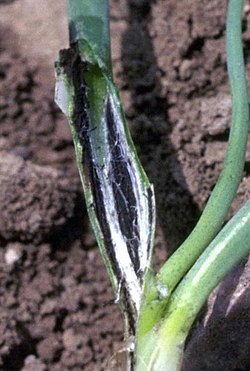Biology:Urocystidales
| Urocystidales | |
|---|---|

| |
| Urocystis colchici on onions | |
| Scientific classification | |
| Domain: | Eukaryota |
| Kingdom: | Fungi |
| Division: | Basidiomycota |
| Class: | Ustilaginomycetes |
| Order: | Urocystidales R. Bauer & Oberw., 1997[1] |
| Synonyms[2] | |
| |
The Urocystidales are an order of fungi within the class Ustilaginomycetes. The order contains 6 families and about 400 genera. They are a sister order to Ustilaginales.
Urocystidales is also known and classified as the smut fungi.[3] They are serious plant pathogens, Urocystis, is one of the representative genera of the order, it is an example of a smut genus that has a wide host range. The type species Urocystis occulta (Wallr.) A.A. Fisch. Waldh (1867), was described as a pathogen on rye (Secale cereale).[4] They are found in marine and terrestrial environments.[1] The aquatic members of the Doassansiopsis genera are found in the tropics or subtropics.[5]
Morphology
They are distinguished from other fungi by the existence of haustoria (root-like structure) and pores in the septa of soral hyphae.[6][7]
Families
It was formed in 1997,[7] and consisted (then) of 4 families, (Doassansiopsidaceae, Glomosporiaceae, Melanotaeniaceae and Urocystidaceae with 1 genus.[8]
Later, Melanotaeniaceae was moved to the Ustilaginales order by Begerow et al. in 2006,[6][9] and others were added such as Fereydouniaceae and Floromycetaceae in 2014 S. Nasr, Soudi, H.D.T. Nguyen, M. Lutz & Piątek, and Mycosyringaceae in 2008.[6][10]
As accepted by GBIF[11] and others;[12]
- Doassansiopsidaceae (19) - only includes Doassansiopsis
- Fereydouniaceae (3) - includes Fereydounia
- Floromycetaceae (21) - includes Antherospora and Floromyces
- Glomosporiaceae (117) - includes Thecaphora (incl. Glomosporium[13] Sorosporium)
- Mycosyringaceae (5) - includes Mycosyrinx
- Urocystidaceae (228) - includes Flamingomyces, Melanoxa, Melanustilospora, Mundkurella, Tuburcinia, Urocystis, Ustacystis and Vankya
Figures in brackets are approx. how many species per family.[11]
Note the DNA of family Doassansiopsidaceae has been studied.[14]
Ecology
The leaves of the water-lily (Nymphaea nouchali) can be affected by the water-born fungi, Doassansiopsis nymphaea.[15]
The leaves of Caldesia parnassifolia (Alisma reniforme) can be affected by the water-born fungi, Doassansiopsis hydrophila (A.Dietr.) Lavrov (syn Doassansiopsis martianoffiana).[16]
References
- ↑ 1.0 1.1 "Urocystidales". WoRMS - World Register of Marine Species. https://www.marinespecies.org/aphia.php?p=taxdetails&id=437260.
- ↑ Urocystidales in MycoBank.
- ↑ Lutz, Matthias; Vánky, Kálmán; Bauer, Robert (2012). "Melanoxa, a new genus in the Urocystidales (Ustilaginomycotina)". Mycological Progress 11: 149–158.
- ↑ "Urocystis occulta CBS 102.71 v1.0". https://mycocosm.jgi.doe.gov/Uroocc1/Uroocc1.home.html.
- ↑ E. B. Gareth Jones, Kevin D Hyde and Ka-Lai Pang (editors) Freshwater Fungi: and Fungal-like Organisms (2014), p. 113, at Google Books
- ↑ 6.0 6.1 6.2 David J. McLaughlin and Joseph W. Spatafora (editors)Systematics and Evolution: Part A, Part 1 (2014), p. 318, at Google Books
- ↑ 7.0 7.1 R., Bauer; F., Oberwinkler; K., Vánky (1997). "Ultrastructural markers and systematics in smut fungi and allied taxa.". Can. J. Bot. 75: 1273–1314. doi:10.1139/b97-842.
- ↑ Geoffrey Clough Ainsworth Ainsworth & Bisby's Dictionary of the Fungi (2008), p. 715, at Google Books
- ↑ Begerow D, Stoll M, Bauer R.2006. A phylogenetic hypothesis of Ustilaginomycotina based on multiple gene analyses and morphological data. Mycologia 98: 906–916
- ↑ Vánky K, Lutz M, Bauer R.2008. About the genus Thecaphora (Glomosporiaceae) and its new synonyms. Mycological Progress 7: 31–39
- ↑ 11.0 11.1 "Urocystidales" (in en). https://www.gbif.org/species/8035892.
- ↑ Outline of Basidiomycota, Mao-Qiang He, Rui-Lin Zhao, in Encyclopedia of Mycology, 2021
- ↑ Vánky, Kálmán; Lutz, Matthias; Bauer, Robert (2008). "About the genus Thecaphora (Glomosporiaceae) and its new synonyms". Mycological Progress 7: 31–39.
- ↑ Begerow, D., Bauer, R. & Oberwinkler, F. 1998. Phylogenetic studies on nuclear large subunit ribosomal DNA sequences of smut fungi and related taxa. – Canadian Journal of Botany 75 [1997]: 2045-2056.
- ↑ Dr.V.R. Patil Research on Fresh water fungi (2015), p. 113, at Google Books
- ↑ B D Borse, K N Borse, S Y Patil, C M Pawara, L C Nemade and V R Patil Freshwater Higher Fungi of India (2015), p. 178, at Google Books
Other sources
- C.J. Alexopolous, Charles W. Mims, M. Blackwell et al., Introductory Mycology, 4th ed. (John Wiley and Sons, Hoboken NJ, 2004) ISBN:0-471-52229-5
Wikidata ☰ Q145853 entry
 |

